September 16, 2022
Air Date: September 16, 2022
FULL SHOW
SEGMENTS
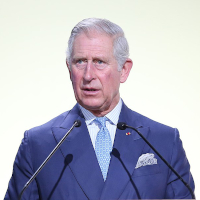
The Green King
View the page for this story
King Charles III, the former Prince of Wales, has acceded to the throne and brings with him a lifelong passion for nature and environmental causes. His longtime advisor and co-author Tony Juniper joins Host Steve Curwood to discuss His Majesty’s contributions on environment and climate, how that might influence him in his new role as King, and the passing of the activist torch to his son William, the new Prince of Wales. (14:05)
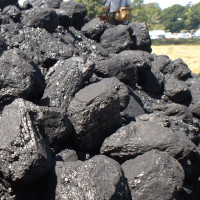
Beyond the Headlines
/ Peter DykstraView the page for this story
On this week's trip beyond the headlines, Environmental Health News editor Peter Dykstra and Host Steve Curwood inspect a provision in the Inflation Reduction Act that ensures permanent funding to help coal miners suffering from black lung. Then, the pair look at a legal loophole where European countries are burning wood pellets from logging in ancient forests and passing it off as "clean energy". Finally, the two look through the history books at the 35th anniversary of the Montreal Protocol, which addressed the dangerous ozone holes at Earth’s poles. (04:52)

Greening the Golden State
View the page for this story
California has been a national leader on tackling climate change and recently announced two changes to further green the golden state. First, California will ban the sale of most new gas-powered vehicles by 2035. Second, and more controversially, Governor Newsom approved an extension for the life of the Diablo Canyon nuclear power station, which is carbon-free but not without risk. CalMatters environmental policy reporter Nadia Lopez joins Host Bobby Bascomb to discuss the implications of these decisions. (10:39)

Upcoming Sept 23 Live Event with Jane Goodall!
“Local Voices, Local Choices: The Tacare Approach to Community-Led Conservation” is the story of the Jane Goodall Institute’s holistic approach to conservation, which puts the local people in charge of preserving their surrounding ecosystems. Join us online Friday September 23rd at 5:30pm Eastern time and find out more at loe.org/events. ()

‘Forever Chemicals’ Are Now Everywhere, Too
View the page for this story
PFAS, or per- and polyfluoroalkyl substances, are a class of over 12,000 chemicals known as “forever chemicals” because they hardly break down in the environment. And they’re now found everywhere from microwave popcorn to drinking water supplies to human blood. Laurel Schaider, Senior Scientist at the Silent Spring Institute, joins Host Bobby Bascomb to talk about the research on how these chemicals are affecting us and what we can do about it. (17:14)
Show Credits and Funders
Show Transcript
HOSTS: Bobby Bascomb, Steve Curwood
GUESTS: Tony Juniper, Nadia Lopez, Laurel Schaider
REPORTERS: Peter Dykstra
[THEME]
CURWOOD: From PRX – this is Living On Earth.
[THEME]
CURWOOD: I’m Steve Curwood.
BASCOMB: And I’m Bobby Bascomb.
As Prince of Wales, King Charles III was a fierce advocate for the environment.
JUNIPER: As an environmentalist growing up in the 70s, one thing that really inspired me was hearing somebody from the establishment who was prepared to speak out on these subjects, because there wasn't literally anybody else. He really is one of the most outstanding environmental leaders the world has seen.
CURWOOD: Also, California bans the sale of most new gasoline cars by 2035.
LOPEZ: California’s transportation sector accounts for about 40-50% of the state’s greenhouse gas emissions. The air resource board projects that the new rule will significantly reduce passenger vehicle emissions by more than 50 percent by 2040.
CURWOOD: That and more this week on Living on Earth – Stick Around!
[NEWSBREAK MUSIC: Boards Of Canada “Zoetrope” from “In A Beautiful Place Out In The Country” (Warp Records 2000)]
The Green King
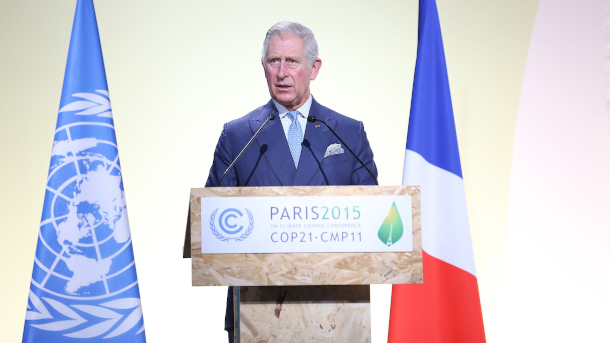
King Charles III, who was then Prince of Wales, addressed the opening of the COP21 UN climate conference in Paris in 2015. (Photo: UNclimatechange, Wikimedia Commons CC BY 2.0)
[THEME]
BASCOMB: From PRX and the Jennifer and Ted Stanley studios at the University of Massachusetts Boston, this is Living on Earth, I’m Bobby Bascomb.
CURWOOD: And I’m Steve Curwood.
KING CHARLES III: This is a call to revolution. The Earth is under threat. It cannot cope with all that we demand of it. It is losing its balance and we humans are causing this to happen.
CURWOOD: That’s His Majesty King Charles III reading the opening words of his 2010 book Harmony: A New Way of Looking at Our World, back when he was still the Prince of Wales.
KING CHARLES III: Revolution is a strong word and I use it deliberately. The many environmental and social problems that now loom large on our horizon cannot be solved by carrying on with the very approach that has caused them. If we want to hand on to our children and grandchildren a much more durable way of operating in the world, then we have to embark on what I can only describe as a “sustainability revolution” – and with some urgency.
CURWOOD: Now that his majesty King Charles III has ascended to the throne, he is perhaps the most prominent environmental advocate to become head of state for a major world power. Tradition suggests the new king will not be as publicly outspoken as he was as crown prince, but now may well use his new powers to advance the causes of nature and environmental protection from behind the scenes. King Charles co-authored “Harmony” with Tony Juniper, a former head of Friends of the Earth England who for decades has advised the new sovereign on the environment and climate. Tony now chairs Natural England, a government conservation agency and joins us from London – welcome back, Tony!
JUNIPER: Lovely to see you, Steve. Nice to be back.

King Charles III processed from Buckingham Palace to Westminster Hall on September 14, 2022 for the Lying-in-State of Elizabeth II. (Photo: Katie Chan, Wikimedia Commons CC BY-SA 4.0)
CURWOOD: So, Tony, please give us a bit of the backstory on how King Charles III has made environment and climate central to his work over the years. How did he use his stature as Prince of Wales to advocate for it?
JUNIPER: It's been a remarkable contribution, looking back from the vantage point of now and the sad moment when Her Majesty Queen Elizabeth II has passed on, and he now is King. And it's a moment to reflect on not only the future, but also the past and the incredible amount of work that King Charles did as Prince of Wales on these environmental subjects, going literally back to the late 1960s, this is a long time ago. And working with him on "Harmony," it became clear that the reasons he did this and chose this path, to use his position as Prince of Wales to champion these environmental causes, it was really because of a sense of disquiet he was feeling as he was growing up during the 1950s and 60s, when you could see the world changing very quickly. The landscape literally changing before his eyes, with the removal of woodlands and hedgerows, the drainage of wetlands, the massive use of pesticides, ancient town centers being pulled down and replaced with concrete blocks. All of these and many other things began to cause him to wonder if we were on a very wrong path. And so he decided to use his position in order to raise awareness about all of these subjects. And so as time went on, it moved beyond wildlife and pollution in this country to embrace global issues, including climate change and tropical deforestation. And so the speeches and the books have been quite famous, quite rightly. But he also set up a number of organizations, charitable organizations that sought to help do the work. He's visited countless locations across the globe, where he's met people trying to make a difference and given them encouragement. And for me, as an environmentalist growing up in the 70s, Steve, one thing that really inspired me was hearing somebody from the establishment who was prepared to speak out on these subjects, because there wasn't literally anybody else. And so I think, you know, in some ways, he really is one of the most outstanding environmental leaders the world has seen.
CURWOOD: How fair is it to say that the environment has been King Charles III, former Prince of Wales, his life's work?
JUNIPER: I think it would be very fair to say that, Steve, recognizing that for him, environment is a very broad concept. And for him, the environment is not simply climate change. It's a whole range of different questions that come together in some pretty fundamental places, including around these ideas of harmony, which is what he expressed in that book that he published back in 2010, that I was lucky enough to help him with alongside Ian Skelly. And that work, I think, is a great example of the different ways in which he draws connections between all of these things, public health, the food supply, how we educate young people, the very way in which we conduct economics. All of these things, he would say, are environmental questions, and he's sought to explain them as environmental subjects as time has gone on.
CURWOOD: What was the eye opening set of experiences for him that drew him to the broad concept of the environment? For many of us, of course, it's time outside in wild or certainly natural places. But to what extent do you know about what really inspired him to begin in this direction?
JUNIPER: I think one thing that inspires a lot of environmental advocates, and certainly me, and I know to an extent him also, is a love of nature. And that love of nature comes with familiarity of the natural world. And one time on a visit to his house in Scotland, very close to Balmoral, we went for a walk by a river where he used to be taken by his grandmother, the Queen Mother, and they used to fetch water from the river in the tea pot and take it indoors, boil it on an open fire to make tea. And that connection with the natural world at an early age and in that way, which was very much linked to family and linked to great times and having moments with his grandmother, this evidently left an impression on him in terms of the importance of natural areas and the outdoors to him. And again, like many other environmentalists, once you start to develop your love of nature, then you develop this shock and horror when you see the destruction of nature. And Rachel Carson, another great environmental leader from the United States, in her case, made similar points about how an ecological awareness leads to quite painful experiences when you see what is going on. And I think that's what happened for him. Having developed this love of the beauty and the wonders of the natural world, before your very eyes, you see it being destroyed by people who apparently don't care. But basically what's going on is that they don't know. And if they don't know, what can you do? Well, you have to help them understand the consequences. And so I think it was that series of steps: of love, horror, and passion to do something about it that basically took him to where he was for so many years as Prince of Wales as this very passionate, very hardworking, very determined environmentalist. And he leaves an incredible legacy, with 50 years of that under his belt.
CURWOOD: So now, in 2022, the Prince of Wales, Charles the Prince of Wales becomes King Charles III. What can he do now to follow his concerns about the environment as the sovereign now of the UK, which, at least in my lifetime, has been fairly apolitical in public stance; certainly, Queen Elizabeth II was publicly very apolitical.
JUNIPER: The role of sovereign is different to the role of Prince of Wales. And nobody knows that more than the new King Charles III. And he has been on the record over recent times, including as recently as last week, when he came to the throne, to reinforce the idea that he knows he's now going to need to do things differently in the new role that he now occupies. But irrespective of that, I think the very fact of him having spent so long and so successfully driving forward this agenda, that it actually in some ways, it doesn't really matter whether now he is constrained. Because the role of, of sovereign, of Monarch, it's something which is about what it stands for, as much as what the holder of the role does, if that makes sense. So the very fact of him having been such a prominent environmentalist for so long, I think automatically means now that with him as the holder of that role, the embodiment of that role, then automatically, almost, it has to have an ecological dimension to it.
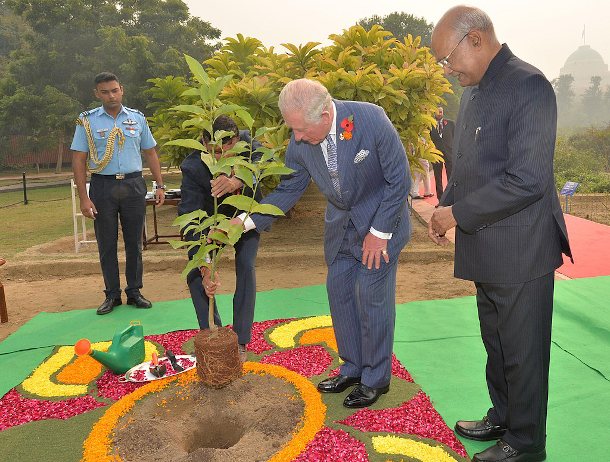
King Charles III, who was at the time Prince of Wales, plants a tree with Indian President Ram Nath Kovind in 2019. (Photo: Government of India, public domain)
CURWOOD: As I understand it, traditionally, once a week or so the prime minister meets with the monarch. Those are private meetings, as far as I know, never really disclosed to the public. To what extent do you think that King Charles III might take that opportunity to have comments about environment and conservation to the Prime Minister?
JUNIPER: I have no idea, Steve; nobody will know because those meetings are strictly confidential, and nothing ever leaks out either from the prime minister or the palace. And so that remains a conversation between the head of state and the head of government, and the rest of us won't necessarily know the details. But you know, if one is speculating about the role of monarch and the interests of the monarch, and the extent to which one of the things they are there to do is to warn of danger and to take the long view, then the subjects that he has been so passionately engaged with certainly will be in both of those categories: of danger factors for the realm and the planet, and very much about the long term interests of society, not just the coming weeks or the coming months or even the next few years.
CURWOOD: So now that the new Prince of Wales, Prince William, takes over, to what extent do you think he was tutored by his father in the environment? He has, of course, this challenge fund that he's already put out; he's made some speeches along these lines. What do you think will be his level of enthusiasm to address the environment and conservation?
JUNIPER: Like his father, Prince William, who now is taking on the role of Prince of Wales, has expressed quite a lot of interest in quite a range of issues: mental health, the well being of veterans, and of course, the environmental issues. And the environmental piece is coming out more strongly as time has gone on, with the Earthshot Prize being the most recent example of that. But if you look back over the recent history of all of this, you know, it's worth remembering that the Duke of Edinburgh, so King Charles's father, was also a passionate environmentalist and worked as the international president for WWF for some time, and was involved with the Wildfowl and Wetlands Trust here, which is now a more global organization working on wildlife and wetlands. He was very involved with all of those things. Actually, there was a remarkable moment here a few years ago when we had all three generations, the Duke of Edinburgh, the then-Prince of Wales, and then-Prince William coming together to launch an initiative called United for Wildlife, which was about cracking down on the illegal wildlife trade, so tiger parts and elephant ivory and some of these despicable activities that continue. The three of them came together to try and kickstart some more determined action to do something about that, which was a lovely thing to see.
CURWOOD: Fascinating. Tony, how much support is there currently now among the public in the UK for acting on nature and climate issues, and really the crisis around the climate?
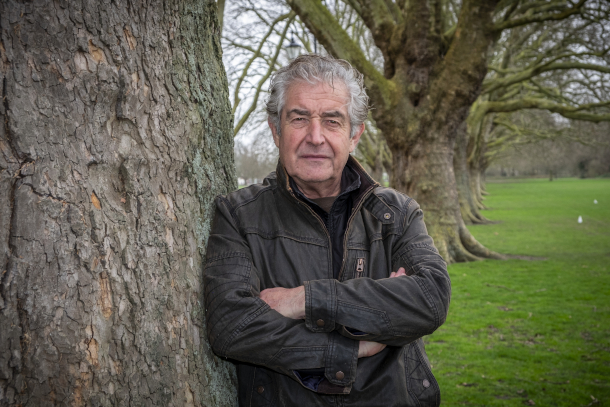
Tony Juniper has been a longtime advisor to King Charles III on environment and climate matters and co-authored two books with him on the subjects. He’s currently Chair of Natural England and former head of Friends of the Earth UK. (Photo: Jason Bye, courtesy of Tony Juniper)
JUNIPER: Yeah, the appetite for action in this country dramatically transformed over the last few years. And we've had a whole raft of new policies and initiatives come from government, which reflect that very deep shift in the public mood on all of this. And, you know, Boris Johnson's government were very energetic in bringing forward new agricultural policies, new targets for curbing biodiversity loss, doing more on the net zero agenda. And I'm very much hoping that the new government will stick in that similar vein. Because like many other countries, we have a short term cost of living crisis, hopefully a short term cost of living crisis, which has diverted attention. But of course, trying to resolve that cost of living crisis through rolling back environmental action, it's a false narrative. It won't work. And also, of course, just leaves these things to get bigger for later. I think a lot of people are beginning to see that actually, the same things that we need to do for climate change are the same things we need to do to manage rising prices, recognizing now that the cheapest energy that we can get in this country is renewables. And so the idea that we can deal with the crisis by pumping more gas, it's just plain wrong, because these big questions are not going away. They're becoming very real now, in terms of the consequences that we see for people and in this country we've had an historical unprecedented drought period, which has caused big impacts on the water supply, on food production. And at the same time, we're looking at what's going on in Pakistan with the terrible effects for people there, with rocks the size of small cars coming down mountainsides in unprecedented monsoon rains. We're living in "the era of consequences," as Winston Churchill would have called it. And I think if we're going to have leaders fit for the world that we now live in, they've got to keep this front and center.
CURWOOD: Tony Juniper is chair of Natural England and longtime adviser to King Charles III, with whom he's co-authored two books on the environment. Tony, thanks so much for taking the time with us today.
JUNIPER: Steve, it was an absolute pleasure to share a few thoughts at this historic moment. Thank you.
Related links:
- The Guardian | “Will Charles III Be as Green a King as He Was a Prince?”
- About Tony Juniper
- Listen to our previous conversation with Tony Juniper about his book “Rainforest”
[MUSIC: Leon Bridges, “Beyond” on Good Things, Columbia Records]
BASCOMB: Coming up – Good news for former coal miners suffering with black lung disease. That’s just ahead on Living on Earth.
ANNOUNCER: Support for Living on Earth comes from Sailors for the Sea and Oceana. Helping boaters race clean, sail green and protect the seas they love. More information @sailorsforthesea.org. Support also comes from Friends of Smeagull the Seagull and Smeagull’s Guide to Wildlife. It’s all about the wildlife right next door to you! That’s Smeagull, S - M - E - A - G - U - L - L, SmeagullGuide.org.
[CUTAWAY MUSIC: Ray Charles, “Dawn Ray” on The Genius After Hours, by Ray Charles, Atlantic Masters]
Beyond the Headlines
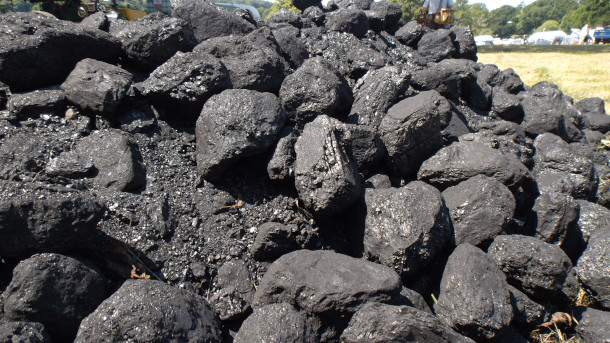
Coal workers' pneumoconiosis (CWP), commonly known as "black lung disease," occurs when coal dust is inhaled over periods of time resulting in scarred lung tissue and impairing the ability to breathe. (Photo: Oatsy 40, Flickr, CC BY 2.0)
BASCOMB: It’s Living on Earth, I’m Bobby Bascomb
CURWOOD: And I’m Steve Curwood.
And with me now on the line from Atlanta is Peter Dykstra. Peter is an editor with Environmental Health News, that's ehn.org and dailyclimate.org. He goes over what's going on beyond the headlines for us from time to time. Hi there, Peter, what you got?
DYKSTRA: Well, hi, Steve, there's an item from our friends at Allegheny Front about the Inflation Reduction Act. Here's something that's good news for coal miners that's buried in the act: $149 million in a fund that's been temporary, now permanent and annual, to help with treatment of coal miners black lung disease. This is a particularly horrible disease, made more horrible by the fact that so many miners don't have any financial help in paying off the bills, because so many coal companies have gone bankrupt, gone out of business. And they're not there to fill any legal requirements to pay for diseases they cause.
CURWOOD: This feels like environmental justice to me, because the folks that went down in those coal mines for all those decades, to power our economy really made our modern society possible, and to just kick them to the curb with a horrible disease seems very unfair. This can't give them back their health, but at least make it possible for them to get treated. Peter, what else do you have for us?
DYKSTRA: Here's a really weird story. And in a segment called Beyond the Headlines, we don't normally go to a publication like The New York Times, but they published a remarkable investigation on how Europe is choking the rest of the world around on its carbon credits. Countries like Romania in Eastern Europe are cutting down what are supposed to be its protected ancient forests. They're turning the trees into sawdust, which are then made into woodchips, which are then shipped to other countries like France and Italy, to be burned in what is considered to be clean energy. It's just a complete wraparound. The countries in Eastern Europe, all legal, by the way, get to cut down their forests, and the countries in Western Europe, ship them cash and get to claim credit for helping solve the climate problem, which of course it doesn't.
Europe is sacrificing its ancient forest for wood biomass pellets.
— WildEarth Guardians (@wildearthguard) September 8, 2022
P.S. As our friends at @DogwoodAlliance could tell you, forests and communities across the Southern U.S. are also being sacrificed for European wood biomass pellets. https://t.co/P4OzcLMmgD
CURWOOD: Yeah, I mean, it makes no sense. Because, Peter, when you cut down a tree, especially an old big one, not only are you releasing the carbon from that tree, if it's burned into the atmosphere, but you're taking that tree out of commission for taking the the carbon out of the atmosphere that it's done for presumably decades. It's like double trouble and not exactly smart.
DYKSTRA: Right. And even though these stories appeared in The New York Times, this information, and the real hard work, started with a nonprofit called the Environmental Investigation Agency. They're known over the years for a lot of revelatory work on fisheries and marine mammals. They've also been doing terrestrial work like this that are some very courageous and very important investigations.
CURWOOD: Well, glad to get that story, Peter. And let's take a look back now in history and tell me what you see.
DYKSTRA: September 16th, 1987. We're talking about the 35th anniversary of a landmark environmental treaty, a treaty that actually works to protect the environment, the Montreal Protocol, calling for the phase out of CFCs, chlorofluorocarbons and other chemicals that deplete the Earth's protective stratospheric ozone layer. Not only is it a major problem for human health, but it's a larger environmental problem. The ozone holes as they're known, show up at the North Pole with an even bigger one at the South Pole. And the good news out of all of this is that even though it took 25 years, it was 10 years ago on September 12th, 2012, that the World Meteorological Organization reported that the ozone hole over the Antarctic had finally gotten smaller over the past year, for the first time ever. It hasn't happened every year since. But the trend is clear. We're reversing the ozone damage. And a global treaty actually wins one for the environment that's so rare.
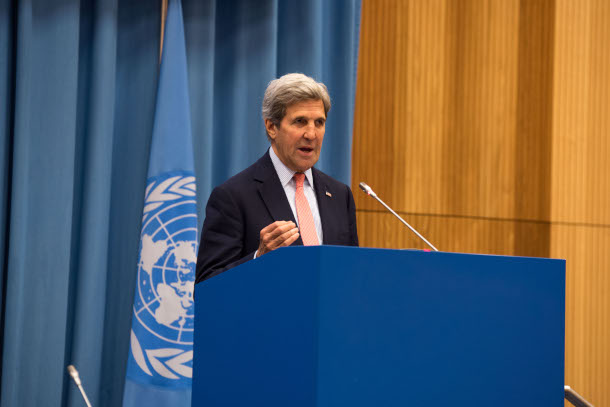
John Kerry the United States Secretary of State, addressing the Montreal Protocol Conference, Third Extraordinary Meeting of the Parties on July 22, 2016. John Kerry is now the United States special presidential envoy for climate. (Photo: UNIS Vienna, Flickr, CC BY-NC-ND 2.0)
CURWOOD: Well and so important because it demonstrates that if we all work together around this planet, that we can help heal what we've done to it. Peter Dykstra is an editor with Environmental Health News, that's ehn.org and dailyclimate.org. We'll talk to you again real soon, Peter.
DYKSTRA: Okay, Steve, thanks a lot. We'll talk to you soon.
CURWOOD: And there's more on these stories on the Living on Earth webpage, that's loe.org.
Related links:
- The Allegheny Front “Climate Law Has A Hidden Benefit For Coal Miners: Permanent Funding For Black Lung”
- The New York Times | “Europe Is Sacrificing Its Ancient Forests for Energy”
- Learn more about the Montreal Protocol
[MUSIC: Thelonious Monk, “Four in One” on Genius of Modern Music, Volume 2, by Thelonious Monk, Blue Note]
Greening the Golden State

California’s landmark phase-out of most gas-powered vehicles may spur other states to follow suit and enact similar regulations. (Photo: Noya Fields, Flickr, CC BY-SA 2.0)
BASCOMB: California has been a national leader on tackling climate change and recently announced two changes to further green the golden state. First, California will ban the sale of most new gas-powered vehicles by 2035. The California Air Resources Board approved the rule aimed at improving air quality and reducing global warming emissions in the state. Second, and more controversially, Governor Newsom approved an extension for the life of the Diablo Canyon nuclear power station. Amid the current heat waves and spikes in energy demand, the Governor has said the state has the choice to keep the facility or risk electricity outages or rely on fossil fuels in the short term until renewable energy can provide more baseline power. For more on this and California’s new car rules I’m joined now by Nadia Lopez. She’s an environmental reporter for CalMatters and says California is well positioned to make the transition to electric vehicles.
LOPEZ: California already has the largest zero emission car market in the country, there are more than a million plug in vehicles, other zero emission vehicles, hybrids that are registered. And nationally, there are about 2.64 million. So it represents about 43% of all zero emission cars that are currently on the road. Automakers are ramping up their fleet of electric vehicles. They knew that this mandate was coming. In addition to that, the technology has significantly improved, and there is a market for it.
BASCOMB: So if any state could do it, it sounds like California is best positioned. But you know, there's some things that are just beyond the control of the state or the auto industry for that matter. You know, things like labor shortages and problems with the supply chain, which we've seen a lot of in the last couple of years.
LOPEZ: Yeah, a lot of these issues are due in part to the pandemic. And it's across the board. We've seen surging gas prices, we've seen inflation effect, and it's no different when it comes to the auto market. There are supply chain shortages when it comes to availability of microchips. In addition to that, mining certain resources, like lithium, are also top concerns--if there's going to be enough of it to produce the amount of electric vehicles that will be needed. So these are real challenges that the state acknowledges and that automakers are also trying to address.
BASCOMB: Well, how is the state of California planning to support the industry and consumers, you know, through this transition?
LOPEZ: Yeah, so the Air Resources Board has included certain provisions in the mandate that would ease the strain on automakers. So automakers will be allowed to use a credit-based system that allows them to meet a lower percentage of sales, if they offer cheaper cars at dealerships and participate in state subsidy programs, which offer rebates or grants to low and middle income people so that they can purchase an EV. You know, the state wants to encourage automakers to participate, not just to ease the strain on them, but also to ease to high cost on consumers.
BASCOMB: Right, I mean, electric vehicles can be prohibitively expensive for a lot, if not most people.
LOPEZ: Oh yeah, definitely. I mean, right now, a new car can cost anywhere between $25,000 and $120,000, depending on the kind of model and year and so forth. So that's still really out of reach for a lot of people.
BASCOMB: Now, from what I've read, car manufacturers supported this change in California. And I mean, they're saying that the timeline is a bit challenging, but overall, they're in support of it. How likely is it that this change in California will spur similar shifts in other states?
LOPEZ: Yes, automakers are on board. They have already each year been increasing the number of models that they have, the number of electric vehicles that are available on the market are continuously improving, longer mile range and so forth, and stronger and more durable batteries. So they're poised to expand that market, across the nation and globally as well. And right now, 17 states have vehicle emission standards that are similar to California's and modeled after California's. California has a special waiver from the federal government to enact stricter emission rules and mandates than those of the federal government. And usually, other states tend to follow suit. So already, Washington, Massachusetts, New York, Oregon, Vermont are a few of those states that plan on instituting a very similar mandate to that of California's. The European Union is also poised to mandate zero emission vehicles by 2035.
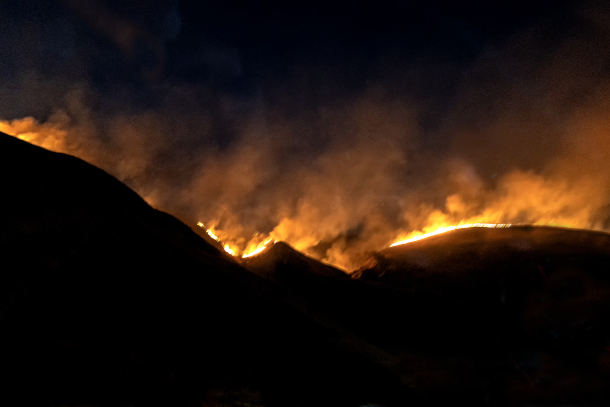
As extreme heat waves attributed to climate disruption drive up demand for power across California, legislators are fighting to maintain energy security as they try to reduce carbon emissions. (Photo: Russ Allison Loar, Flickr, CC BY-NC-ND 2.0)
BASCOMB: Now, the rule was set in place in California by the Air Resources Board as an aggressive way to tackle the state's air quality. How do they expect air quality might improve as a result of this measure? And you know, for that matter, what kind of improvements might we expect in public health with better air?
LOPEZ: Right, so California's transportation sector--we live in some very car-centric cities--accounts for about 40 to 50% of the state's greenhouse gas emissions. So it's a pretty big sum. The Air Resources Board projects that the new rule will significantly reduce passenger vehicle emissions by more than 50% by 2040. Now, greenhouse gases contribute to smog. They contribute to poor air quality. So as we start to see this reduction in these emissions, you know, we could also start to see improvements in air quality in places in the state that are notorious for that, like the LA basin like the Central Valley, and that's the hope that it will also help reduce respiratory illnesses, asthma that a lot of people attribute to that poor air quality.
BASCOMB: Now, I want to shift gears here for a minute, pun intended, and talk to you about something else that you've been writing about in California. And that is the Diablo Canyon Nuclear facility. Governor Newsom recently signed into law a bill that would extend the life of that nuclear facility. It was slated to close in 2025. But it's been extended for another five years. What did they make that choice to keep it open longer?
LOPEZ: Right, so Diablo Canyon, the nuclear power plant, is the state's last nuclear facility. It basically provides about 10% of the state's power to the electricity grid. And as you may have noticed, California has been experiencing really dire effects due to climate change, and due to these planet warming emissions that we just discussed. So increasingly, as we're facing more intense heat waves, prolonged drought, the state is really worried that it's going to significantly strain the power grid. We've already started seeing those effects. California broke records for this heatwave that we're experiencing, and is asking residents to cut their power use during peak times during the day to prevent rolling blackouts, to prevent rolling brownouts. So, that being said, Governor Newsom decided to reconsider keeping Diablo Canyon open for a few more years in order to meet that demand as a carbon-free source of energy while the state makes a transition to renewable energy sources like solar and wind.
BASCOMB: Nuclear, of course, is very controversial. What are some of the concerns that legislators and Californians have about extending the life of the Diablo Canyon plant?
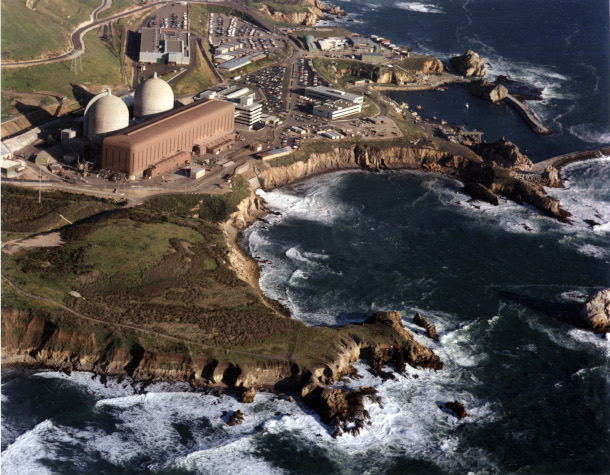
Some opponents of the continued use of the carbon emissions-free Diablo Canyon nuclear power plant argue that it will delay investments in renewable energy. (Photo: Nuclear Energy Commision, Pacific Gas and Electric, Flickr, CC BY-NC-ND 2.0)
LOPEZ: A lot of opponents say that the storing of spent nuclear waste is a huge hazard. They also say the proximity to fault lines and the threat of earthquakes, which California is known for, can pose certain challenges and risks. And while PG and E, Pacific Gas and Electric, the plant's owner, has said that the site remains safe, a lot of people still feel that it could pose a threat to their communities. So apart from that a lot of opponents and some environmentalists are concerned that extending the plant could delay those much-needed investments in renewable energy.
BASCOMB: Right, the state is giving PG and E $1.4 billion loan to do this work to extend the life of the plant. I mean, that's $1.4 billion that could have been spent on solar, wind or any other renewable energy infrastructure, I should think.
LOPEZ: And that was part of the debate. Some people expressed apprehension because that's a lot of money that they say, potentially could have gone to this renewable energy infrastructure instead of continuing to invest in nuclear power.
BASCOMB: I mean, the other side of it, of course, is that nuclear is largely carbon-free, which is of course, very, very attractive right now, as we're facing this climate crisis. You can see how the state's kind of stuck between a rock and a hard place here.
LOPEZ: Right. You know, I think right now, the state's priority is to reduce greenhouse gas emissions. And some people worry that well, if you get rid of this nuclear power facility, which, as I've stated, provides about 10% of the state's power to the electric grid, then are we going to be supplementing that with natural gas, with other forms of fossil fuels? That's a valid question that a lot of people are asking, because, frankly, the infrastructure for a lot of renewable energy isn't completely there. And it's not going to happen overnight.
BASCOMB: Well, I mean, you have to admit that between the ban on new gas-powered vehicles and you know, looking at nuclear as a low carbon energy source, it seems like California, really at least has its head in the right place when it comes to climate change.
LOPEZ: Yes. And California has always been a leader of sorts in implementing aggressive and stringent policies to address climate change. So this isn't a surprise for a lot of people here in the state and for people who follow climate closely.
BASCOMB: Nadia Lopez covers environmental policy issues for CalMatters. Nadia, thank you so much for your time today.
LOPEZ: Thank you so much for having me.
Related links:
- CalMatters | “California Phases Out New Gas Cars–So What’s Next for Electric Cars?”
- California Air Resources Board | “”California Moves to Accelerate to 100% New Zero-Emission Vehicle Sales By 2035”
- CalMatters | “Diablo Canyon: Nuke Plant A Step Closer to Staying Open Longer”
- California Legislative Information | “SB-846 Diablo Canyon Powerplant: Extension of Operations”
- CA.gov | “Proclamation of State of Emergency”
[MUSIC: Orchestra Baobab, “Gnawoe” on Specialist in All Styles, by Orchestra Baobab, World Circuit-Nonesuch]
Upcoming Sept 23 Live Event with Jane Goodall!
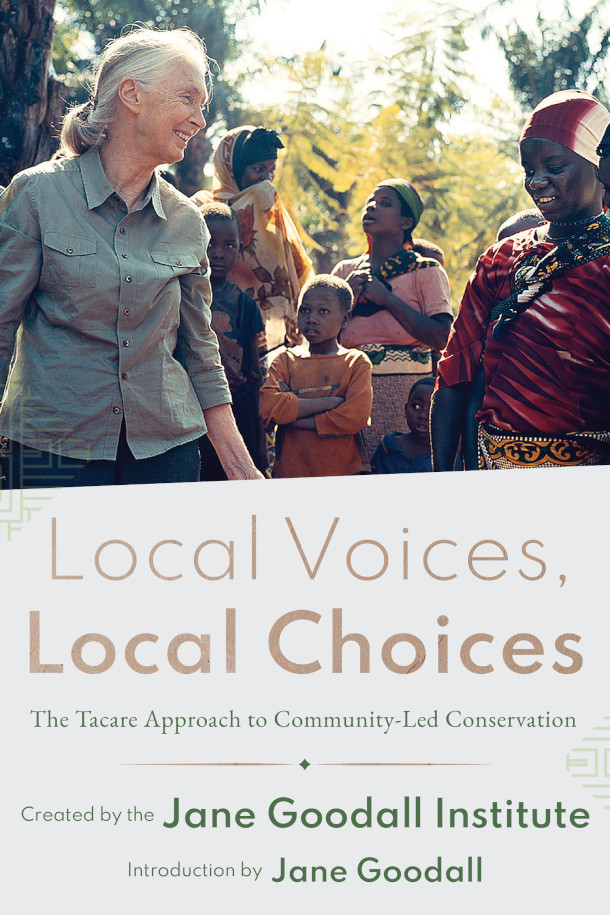
Join us on September 23rd for a live event featuring Dr. Jane Goodall, DBE. (Photo: Courtesy of the Jane Goodall Institute)
CURWOOD: Join us online on Friday September 23 for a discussion with famed primatologist, Jane Goodall* about her new book, "Local Voices, Local Choices: The Tacare Approach to Community-Led Conservation.” That’s Jane Goodall live online Friday September 23rd at 5:30pm eastern time. It’s free! Just register at loe.org/events.
*Editor's note: Dr. Jane Goodall, DBE is also an ethologist and conservationist.
Related link:
Find out more and register for this upcoming live event
[MUSIC: Orchestra Baobab, “Gnawoe” on Specialist in All Styles, by Orchestra Baobab, World Circuit-Nonesuch]
BASCOMB: Coming up – The EPA’s slow walk on toxic PFAS chemicals. That’s just ahead on Living on Earth.
ANNOUNCER: Funding for Living on Earth comes from you, our listeners, and United Technologies, combining passion for science with engineering to create solutions designed for sustainability in aerospace, building industries, and food refrigeration.
[CUTAWAY MUSIC: Arturo Sandoval, “Blues En Fa” on My Passion For The Piano, Written By Arturo Sandova, Columbia]
‘Forever Chemicals’ Are Now Everywhere, Too

As many as 200 million Americans’ drinking water supply may be contaminated with PFAS, but federal testing for PFAS is not mandated. (Photo: LuAnn Hunt on Unsplash)
CURWOOD: It’s Living on Earth, I’m Steve Curwood.
BASCOMB: And I’m Bobby Bascomb
PFAS are a class of over 12,000 chemicals found in countless household and industrial products. Studies have shown links between PFAS and a variety of human health concerns including certain cancers and fertility issues. In August, EPA proposed a new rule to designate two of the most harmful PFAS chemicals, as “hazardous substances” under the Superfund Law, which would hold polluters accountable for cleaning up contaminated sites. Aside from that step, little widespread action has been taken to limit production and use of PFAS as a chemical class. Laurel Schaider is a Senior Scientist and PFAS expert with the Silent Spring Institute.
SCHAIDER: So, at Silent Spring Institute, we've long been concerned about emerging drinking water contaminants. These are chemicals that are potentially present in drinking water but aren't currently being regulated. Back in 2010, we were conducting a study of emerging drinking water contaminants in the waters of Cape Cod. And one of the chemicals that we looked for were PFAS, and we found that they showed up in a number of the wells that we tested. And since then, our research in this area has really grown.
BASCOMB: Now, you were looking on Cape Cod, but studies estimate that the water supply for some 200 million Americans may be contaminated with PFAS. How does that happen? How does PFAS get into the water supply in so many different places throughout the country?
SCHAIDER: PFAS have become a really pervasive class of environmental contaminants. PFAS are widely used in consumer products. They're also used in a common class of firefighting foams that are used at military bases and airports. PFAS chemicals themselves are very persistent; they've been dubbed "forever chemicals" because they basically don't break down in the environment. And they're also very mobile, so they've spread around not only the groundwater and surface waters here in the US, but they've been found all over the world, even in the blood of polar bears at the Arctic.
BASCOMB: How is it getting into all of these, you know, far flung places of the world?
SCHAIDER: PFAS represents a broad class of different chemicals. Some forms of PFAS are what we call volatile, that means that they can actually end up in the atmosphere, and they can circle around the globe in the air. PFAS are also present in the oceans, and we know the water in the oceans circulates throughout the whole globe. So PFAS can reach far corners of the globe that way as well.

The CDC has found traces of PFAS in over 99% of Americans’ blood. Fortunately, long chain PFAS concentrations in blood have been decreasing over time as bans are implemented on PFOA and PFOS, two prominent long chain PFAS. (Photo: Akram Huseyn on Unsplash)
BASCOMB: And as you said, it's not just in water: PFAS is commonly found in the air, in soil. It's also in food that we eat, especially fish and food packaging. It's in cosmetics It's in our clothes. I mean, it's just about everywhere you look, but can you give us some details, please about these other ways that people can be exposed to PFAS other than just water?
SCHAIDER: Food is thought to be a really important source of exposure for the general population. We know that PFAS can enter into the plants and the animals that we eat if there are PFAS in the soil or the water. People who eat more fish and shellfish have been found to have higher levels of PFAS in their blood. PFAS are also widely used in food packaging, for instance, microwave popcorn bags and fast food packaging. PFAS are also widely used in many different types of consumer products. They're in nonstick pans, stain resistant carpets and furniture, waterproof jackets. So they're a part of our daily lives, they're in our indoor environment. They can also end up in dust. PFAS are showing up nearly everywhere that they're tested for.
BASCOMB: So these are called "forever chemicals" because they persist in the environment for so long. It seems like they could also be called "everywhere chemicals," but that name has already been kind of reserved for pthalates, another class of chemicals that are found in similar products. Now, these chemicals are so common that blood tests have actually found PFAS in the vast majority of Americans they sampled. Can you tell us more about that, please?
SCHAIDER: Sure. So testing by the Centers for Disease Control and Prevention has found that over 99% of Americans have traces of PFAS in our bodies. There are certain PFAS chemicals that we call long-chain PFAS based on their long carbon backbone in their chemical structure. These have the ability to accumulate in our bodies for years. Long chain PFAS are no longer being manufactured in the US or Europe, but they're still a part of our environment, and they're still extremely persistent. Now, newer products contain other PFAS chemicals. Some of these are shorter versions of the long chain PFAS that they're intended to replace, and there are other variations of the chemical structures. So we're still being exposed to many different PFAS chemicals, although they don't necessarily tend to accumulate in our blood in quite the same way.

Firefighting foam is one of the largest sources of PFAS, and water sources near airports and military sites where the foam has been used have higher concentrations of PFAS. (Photo: Marty on Unsplash)
BASCOMB: So Laurel, chances are solid that you and I and just about everybody listening to us right now, we all have PFAS in our body. What concerns you about that? What are the potential health concerns associated with PFAS exposure?
SCHAIDER: PFAS exposures have been linked to a wide range of harmful health effects. These range from elevated cholesterol, effects on the thyroid, kidney, and liver, certain types of cancers such as testicular and kidney cancer, effects on the immune system. Studies have shown that children with higher levels of PFAS in their blood produce fewer antibodies in response to routine vaccinations. So the fact that all of us are exposed to PFAS is really concerning.
BASCOMB: Now, these chemicals have been around since the 1940s. But I think we can safely say that our relative exposure has dramatically increased in the last decade or two, here. What do we know, if anything, about the long-term exposure to PFAS?
SCHAIDER: Our exposures to PFAS are changing over time. The Centers for Disease Control and Prevention has actually seen that levels of these long chain PFAS in people's blood is going down over time. However, we're being exposed to different PFAS chemicals now. And we know less about the extent of widespread exposure in the general population to the full suite of PFAS chemicals. And it's really only been in the past 10 or 20 years that chemists have been able to measure the levels of PFAS in people's blood.
BASCOMB: So Laurel, how much exposure is potentially problematic, and does that depend on how people are exposed?
SCHAIDER: As far as we know, there's really no level of exposure that's been identified as being safe. In developing standards for drinking water or fish or other pathways of exposure, EPA and other regulators often develop what's called a reference dose. So this is an amount of PFAS chemical taken into our bodies each day that is not thought to cause a harmful health effect over the long run. These reference doses do take into account body weights, recognizing that children and people with smaller bodies might see health effects at lower levels of exposure. However, one thing we've learned is that these reference doses go down over time as we learn more about the harmful health effects. So what is currently considered a level where we don't think a harmful health effect might occur, that might change in the future with new science if we do learn that these chemicals are actually more toxic than previously thought.

PFAS exposure is associated with a range of negative health effects, such as reduced vaccine effectiveness in children. Other health effects include elevated cholesterol, changes in metabolism, thyroid, liver, and kidney problems, and cancer. (Photo: charlesdeluvio on Unsplash)
BASCOMB: Well, what groups of people or demographics should be really particularly concerned about consuming PFAS or being exposed to PFAS chemicals? Are any groups at higher health risk than others?
SCHAIDER: So certainly, some people are at greater risk of PFAS exposure than others. Some of these groups are defined by their occupation. We know that firefighters can be exposed to elevated levels of PFAS from their use of certain firefighting foams, and the widespread use of PFAS in the protective gear that they wear. People who work in industries where these chemicals are manufactured or incorporated into products are also likely to have much higher levels of exposure than the general population.
BASCOMB: And what about pregnant women and children? Young people that are still developing are very often at higher risk of chemical exposure because they are, you know, just growing so quickly.
SCHAIDER: That's right. We're more sensitive to chemical exposures early in our lives when our bodies are still growing and developing. Unfortunately, we know that PFAS can be passed along from mothers to their children during pregnancy and breastfeeding. So babies are being born with PFAS already in their bodies.
BASCOMB: Now, I've read that some Native American tribes and Asian migrant communities rely on fishing as both a key source of food and a cultural touchstone. But in many cases, these fishing areas are contaminated with PFAS, and the more fish you eat, the more contamination you're exposed to. Can you tell me more about that, about how tribal peoples and immigrant communities are particularly affected by PFAS?
SCHAIDER: Communities that rely more heavily on fish as a source of dietary protein are likely exposed to higher levels of PFAS, particularly if those fish are coming from an area with contamination. And certainly, we know that other types of contaminants like methyl mercury and PCBs can also accumulate in fish and also lead to disproportionately higher exposures in these populations.

PFAS can be passed from mother to child during pregnancy; babies are being born with PFAS already in their bodies. (Photo: freestocks on Unsplash)
BASCOMB: So, to what degree do you see PFAS contamination as an environmental justice issue? Or is this really just an equal opportunity health hazard?
SCHAIDER: I think that PFAS does represent an environmental justice concern. Low income communities and communities of color may have disproportionately high levels of exposure. Many water supplies that are finding PFAS in their source waters are small water supplies, and particularly if these water supplies are located in a lower income community, that means that they may have fewer options for treating water either at the municipal level or at the household level.
BASCOMB: Now, I understand that there is a new PFAS measurement tool called the Total Organic Fluorine test. Can you explain that a bit for us? What does it measure, and how is it different from the test that EPA currently uses?
SCHAIDER: That's right. So one of the hallmarks of PFAS chemicals are that their chemical structures have many fluorine atoms, and so in certain products, like consumer products, say textiles or food packaging, where we see higher levels of fluorine, that's an indicator to us that that's a product that's been treated with PFAS in some way. So we're able to use that total fluorine as a marker or indicator for the presence of PFAS that are added to those products. However, you can't do that exact same type of test on water. We know that there are many different types of PFAS in water, but current testing methods used by EPA and other entities really only look for 20 or 30 chemicals in general. And there may be other PFAS chemicals that we're missing.
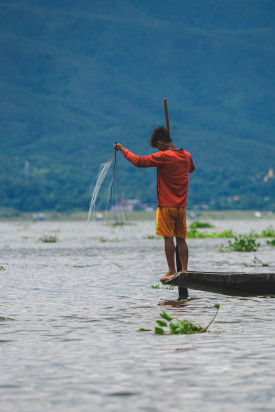
People who consume large quantities of fish, like Native American tribes and Asian immigrant populations, are at higher risk of negative health effects from PFAS. PFAS is an emerging environmental justice concern. (Photo: Zinko Hein on Unsplash)
BASCOMB: But as we mentioned earlier, I mean, you said that there's on the order of potentially 12,000 different PFAS chemicals. So looking at each and every individual chemical is going to be a huge challenge.
SCHAIDER: That's right, there's no way that we'll be able to develop the analytical methods to measure each individual PFAS chemical separately. And certainly we don't expect every single chemical will be able to move in the environment or necessarily show up in our bodies. But, there is a large concern about the PFAS that we're missing with the methods where we look for 10 or 20 or 30 specific PFAS chemicals at a time.
BASCOMB: And I should think at the state level, you also need to look closely at the water supply, which is such an important source of exposure.
SCHAIDER: The EPA currently doesn't have enforceable drinking water standards for any PFAS. The EPA has issued health advisory levels for two specific PFAS chemicals, PFOS and PFOA. Just last month, the EPA revised and issued new health advisory levels for these two chemicals that are orders of magnitude lower than the health advisories that they issued in 2016. And this reflects new information showing that PFAS are actually toxic at lower levels than previously thought. However, the fact that there are no enforceable standards means that under federal law, there is no requirement for public water supplies to test for PFAS. A number of states think that the EPA is not moving quickly enough and have actually put into place their own guidelines or enforceable standards that are stricter than the EPA advisories and are enforceable. However, for millions of Americans, their water supply hasn't even been tested for PFAS. That makes me think that we will be discovering other communities in the future that have contamination that we don't know about right now.

Current EPA testing measures look for only 20-30 PFAS chemicals out of 12,000. A newly developed testing measure called Total Organic Fluorine looks for the presence of fluorine, a general marker of PFAS. (Photo: Hans Reniers on Unsplash)
BASCOMB: Well, I've been looking at the EPA page on PFAS and they outline the same things that we've been talking about here, you know, the pathways to exposure and health concerns, communities at risk. But I didn't see much about removing these chemicals from our environment, you know, taking them off the market. What kind of response have you seen from EPA or any other government agencies when it comes to the concerns associated with this class of chemicals?
SCHAIDER: Much of the response from the EPA and other agencies has focused on how can we reduce people's exposure in the short term. This includes developing and implementing drinking water treatment technologies to make sure that the water that people drink doesn't contain PFAS. There is an increased interest in understanding the levels of PFAS in food, as well as food packaging, and understanding the other ways that PFAS can be getting into our bodies from our environment.

In a study of children’s consumer products, the Silent Spring Institute found that products advertised as “waterproof” or “stain resistant” (e.g., raincoats) were more likely to contain PFAS. (Photo: Janko Ferlič on Unsplash)
There's also a recognized need for better remediation strategies. So where PFAS are found to be present at high levels in the environment, we don't really have a lot of tools to remove those PFAS. Because the PFAS chemicals are so persistent, they don't break down under normal conditions. Incineration is one way to break down PFAS chemicals, but there are a range of concerns about using incineration. It's also not a very sustainable or environmentally practical strategy to move waste long distances in order to be incinerated. Something I've seen more at the state level and from retailers and manufacturers is a move away from using PFAS as a class. So a number of states, including here in Massachusetts, have proposed or enacted bans on things like PFAS in food packaging, and a number of fast food chains and retailers have also made pledges to stop using or selling products that contain PFAS.
BASCOMB: Well, what do you at the Silent Spring Institute think should be done about this class of chemicals that's so concerning?
SCHAIDER: PFAS represent a really large public health challenge. At Silent Spring Institute, we support the idea of the essential uses framework, where PFAS shouldn't be used in products where they don't serve an important function for health or safety or where we have other substitutes that provide the same function without posing the same concerns about toxicity. We also think that it's important to develop better chemical testing regulations so that we avoid putting really persistent and toxic chemicals into products in the first place. Here in the US, chemicals can be put into products and widely used before they've been thoroughly screened for toxicity. We find this really concerning and we think there need to be stricter regulations on chemical safety. Another thing that would be helpful would be to add PFAS chemicals to the Superfund Law, or CERCLA, which means that the polluters who are responsible for the contamination will be required to pay for the cleanup.
BASCOMB: Well, for somebody who's listening to us right now, what can they do to protect themselves and their family? What are the best practices here?
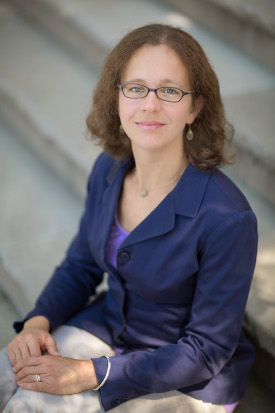
Laurel Schaider is a Senior Scientist with the Silent Spring Institute focusing on PFAS. (Photo: Courtesy of Laurel Schaider)
SCHAIDER: As individuals, we know there are some things that we can do in our daily lives to help limit our exposures to PFAS and other toxic chemicals. We can try to avoid certain types of products, like microwave popcorn bags or stain resistant carpets and furniture. We can keep the dust levels in our house low by frequently vacuuming or mopping our floors. And we can look for products that say they don't contain PFAS. I recently led a study where we did find that products that were labeled as "stain resistant" or "water resistant" were more likely to contain PFAS. But really, at the end of the day, it shouldn't be on all of us as individuals to have toxic chemicals on our mind when we're at the grocery store or buying clothes or furnishings for our homes and our families. There need to be broader level changes to enforce stricter regulations on chemicals and to keep toxic chemicals out of the marketplace.
BASCOMB: Laurel Schaider is a Senior Scientist with the Silent Spring Institute. Laurel, thank you so much for your time today.
SCHAIDER: Thank you so much for having me and covering this really important topic.
Related links:
- Learn more about the Silent Spring Institute
- Learn more about PFAS with the PFAS Exchange
- Learn more about PFAS with STEEP
- Download the Silent Spring Institute’s “Detox Me” App
[MUSIC: Jacqueline Schwab, “Mendocino Morning” on True Blue Waltz, by Peter Barnes, Midsummer Recordings]
CURWOOD: Living on Earth is produced by the World Media Foundation. Our crew includes Naomi Arenberg, Paloma Beltran, Chloe Chen, Iris Chen, Josh Croom, Jenni Doering, Kuka Kahfi, Mark Kausch, Mark Seth Lender, Don Lyman, Louis Mallison, Aynsley O’Neill, Sophia Pandelidis, Jake Rego, Hannah Richter, Ashley Soebroto, and Jolanda Omari. We must say goodbye this week to our intern Delaney Dryfoos. Thanks for all your hard work!
BASCOMB: Tom Tiger engineered our show. Alison Lirish Dean composed our themes. You can hear us anytime at L-O-E dot org, Apple Podcasts and Google Podcasts, and like us, please, on our Facebook page - Living on Earth. We tweet from @livingonearth. And find us on Instagram at livingonearthradio. I’m Bobby Bascomb
CURWOOD: And I’m Steve Curwood. Thanks for listening!
ANNOUNCER: Funding for Living on Earth comes from you, our listeners, and from the University of Massachusetts, Boston, in association with its School for the Environment, developing the next generation of environmental leaders. And from the Grantham Foundation for the protection of the environment, supporting strategic communications and collaboration in solving the world’s most pressing environmental problems.
ANNOUNCER 2: PRX.
Living on Earth wants to hear from you!
Living on Earth
62 Calef Highway, Suite 212
Lee, NH 03861
Telephone: 617-287-4121
E-mail: comments@loe.org
Newsletter [Click here]
Donate to Living on Earth!
Living on Earth is an independent media program and relies entirely on contributions from listeners and institutions supporting public service. Please donate now to preserve an independent environmental voice.
NewsletterLiving on Earth offers a weekly delivery of the show's rundown to your mailbox. Sign up for our newsletter today!
 Sailors For The Sea: Be the change you want to sea.
Sailors For The Sea: Be the change you want to sea.
 The Grantham Foundation for the Protection of the Environment: Committed to protecting and improving the health of the global environment.
The Grantham Foundation for the Protection of the Environment: Committed to protecting and improving the health of the global environment.
 Contribute to Living on Earth and receive, as our gift to you, an archival print of one of Mark Seth Lender's extraordinary wildlife photographs. Follow the link to see Mark's current collection of photographs.
Contribute to Living on Earth and receive, as our gift to you, an archival print of one of Mark Seth Lender's extraordinary wildlife photographs. Follow the link to see Mark's current collection of photographs.
 Buy a signed copy of Mark Seth Lender's book Smeagull the Seagull & support Living on Earth
Buy a signed copy of Mark Seth Lender's book Smeagull the Seagull & support Living on Earth

